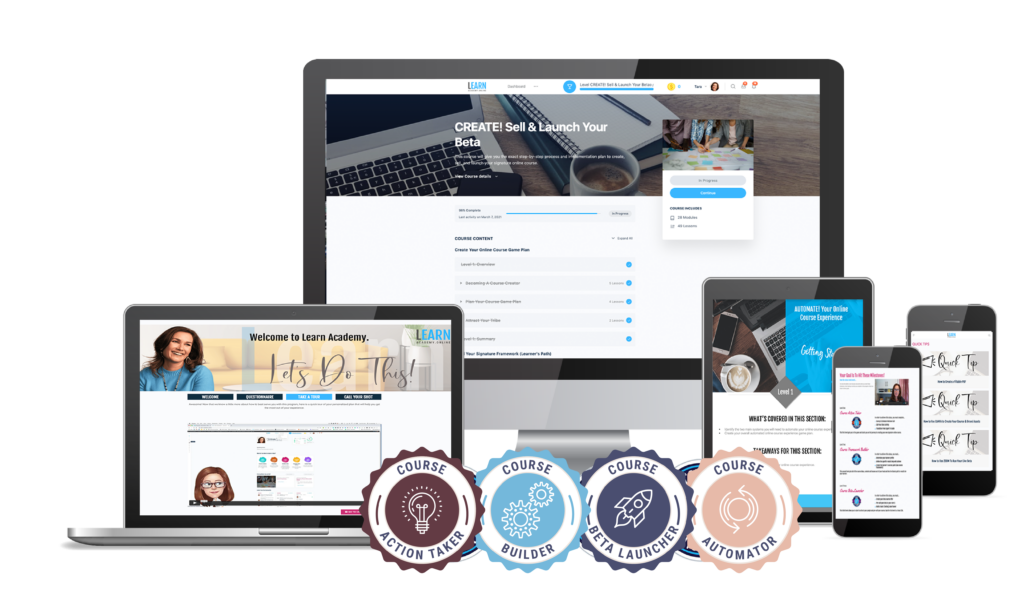Many service providers who have built their businesses on the foundation of personal, 1:1 relationships fear that introducing online tools will diminish the quality of their services.
But what if I told you that using online business tools doesn’t have to be all-or-nothing? You can start small, build confidence, and still deliver the personal touch your customers value.
In this post, we’ll break down how to begin incorporating online business tools into your business in a way that feels manageable and aligned with your values. You’ll walk away with three simple, actionable tips you can start using today to automate and streamline your business—without losing the quality of your customer experience.
Feel Overwhelmed by Online Business Tools?
As a 1:1 service provider, coach or consultant, you are an expert at personal, customized delivery, and may have a concern that moving online or introducing automation will turn your business into a “cold” machine.
But the reality is that you are probably already repeating some processes for every customer—you are just doing it manually.
Take onboarding, for example. Chances are, each new customer goes through a similar process where you set expectations, provide initial resources, and outline the steps of your program. Instead of recreating these steps every time, imagine having an onboarding sequence that welcomes each customer automatically, shares essential resources, and schedules their first call. You’d save time, reduce errors, and ensure that every customer receives the same high-quality experience.
3 Actionable Tips to Ease Overwhelm With Online Business Tools
1. Start by Standardizing Your Onboarding Process
The onboarding phase is one of the easiest areas to automate because it often involves a similar series of steps for each new customer. You can create a simple onboarding email sequence using a tool like ActiveCampaign.
Here’s how:
- Document Your Process First: Write down each step in your onboarding process, from welcoming new customers to setting up their first call.
- Create a Repeatable Template: Set up an email sequence that welcomes new customers, shares next steps, and provides essential resources (e.g., links to your calendar, guides, and introductory videos).
- Implement and Test: Start with one small sequence, test it with your next few customers, and refine as needed.
This small step will not only save you hours but will also ensure that your customers start with a consistent, positive experience.
2. Use Scheduling Tools to Eliminate Back-and-Forth Emails
One of the biggest time-wasters for service providers is the endless back-and-forth of scheduling calls and meetings. Tools like Calendly or Google Calendar can eliminate the hassle by allowing customers to book time directly based on your availability.
Steps to Implement:
- Set Up Your Availability: Block out specific times in your calendar for customer meetings and consultations.
- Create a Custom Scheduling Link: Include options for different types of appointments (e.g., 30-minute discovery call, 1-hour strategy session).
- Share It with Clients Once: Send your link to customers and let them pick times that work for them.
This reduces friction for your customers and prevents scheduling mix-ups, ensuring you’re spending your time where it’s most valuable—actually working with your customers.
3. Create a Client Resource Library
Many service providers spend valuable time answering the same questions and explaining the same concepts to every customer. Building a simple customer resource library—a collection of frequently used documents, tutorials, and guides—can streamline your service delivery.
How to Get Started:
- Identify Repetitive Questions or Tasks: Write down the top 10 questions or topics you explain to customers repeatedly.
- Create Video Tutorials + PDF Guides: Use tools like Loom or Google Meet to record quick tutorials and organize them into a shared folder.
- Set Up a Client Portal: You can use tools like a shared Google Drive folder to store and organize these resources.
This allows your customers to access information on their own time, reducing dependency on your availability while still feeling supported.
Making the Transition Smooth: Focus on Phases
Instead of trying to automate your entire service delivery at once, think in phases. Start by identifying just one small area where you can introduce online business tools, such as your onboarding, scheduling, or resource library. Once you have success there, move to the next phase. This phased approach helps you maintain control, see results quickly, and prevent overwhelm.
Example Phases:
- Onboarding Automation: Create and implement an automated welcome sequence.
- Scheduling Simplification: Use a scheduling tool to eliminate the back-and-forth.
- Client Resource Library: Build a small collection of guides and FAQs to reduce repetitive tasks.
When you approach the transition in phases, you’re creating a blueprint that’s easy to replicate. You’re not losing your personal touch—you’re simply creating consistency and efficiency, allowing you to focus on what really matters: delivering transformation for your customers.
Final Thoughts: Small Wins Lead to Big Changes
Overcoming the fear and overwhelm of moving your business online starts with small, manageable steps. By introducing just a few online business tools, you can free up time, reduce the mental load of managing every detail manually, and create a more seamless experience for your customers.
Start with one area, such as automating your onboarding or using a scheduling tool. As you build confidence and see the positive impact on both your business and customer experience, you’ll be inspired to continue making incremental changes.
Remember, you don’t have to give up the personal touch that makes your service special. These tools are here to support you, not replace you. The goal is to simplify your day-to-day so you can spend more time on high-impact work
Our Host
Tara Bryan is on Instagram | Facebook | Linkedin
Website is: www.Taralbryan.com
Hey, it’s your host, Tara Bryan. And I am on a mission to help more business owners learn to infinitely scale their businesses by leveraging the power of online without sacrificing the customer experience or results.
I like to geek out on all things business strategy, marketing, interactive digital and user experience. This podcast is all about what is working, lessons learned and actionable tips to create and grow a thriving online business.
Join us each week as we dive into different strategies, tactics and tips you can apply immediately to your business.
Key Topics:
- The importance of tech automation for scaling online businesses
- Simple steps to integrate tech without overwhelming the user
- Practical tools and strategies for automating everyday business tasks
Highlights
- Maximize your ability to serve without it taking up all of your time.
- Start small with tech automation to save hours in your business
- Tech should enhance the customer experience, not complicate it.






